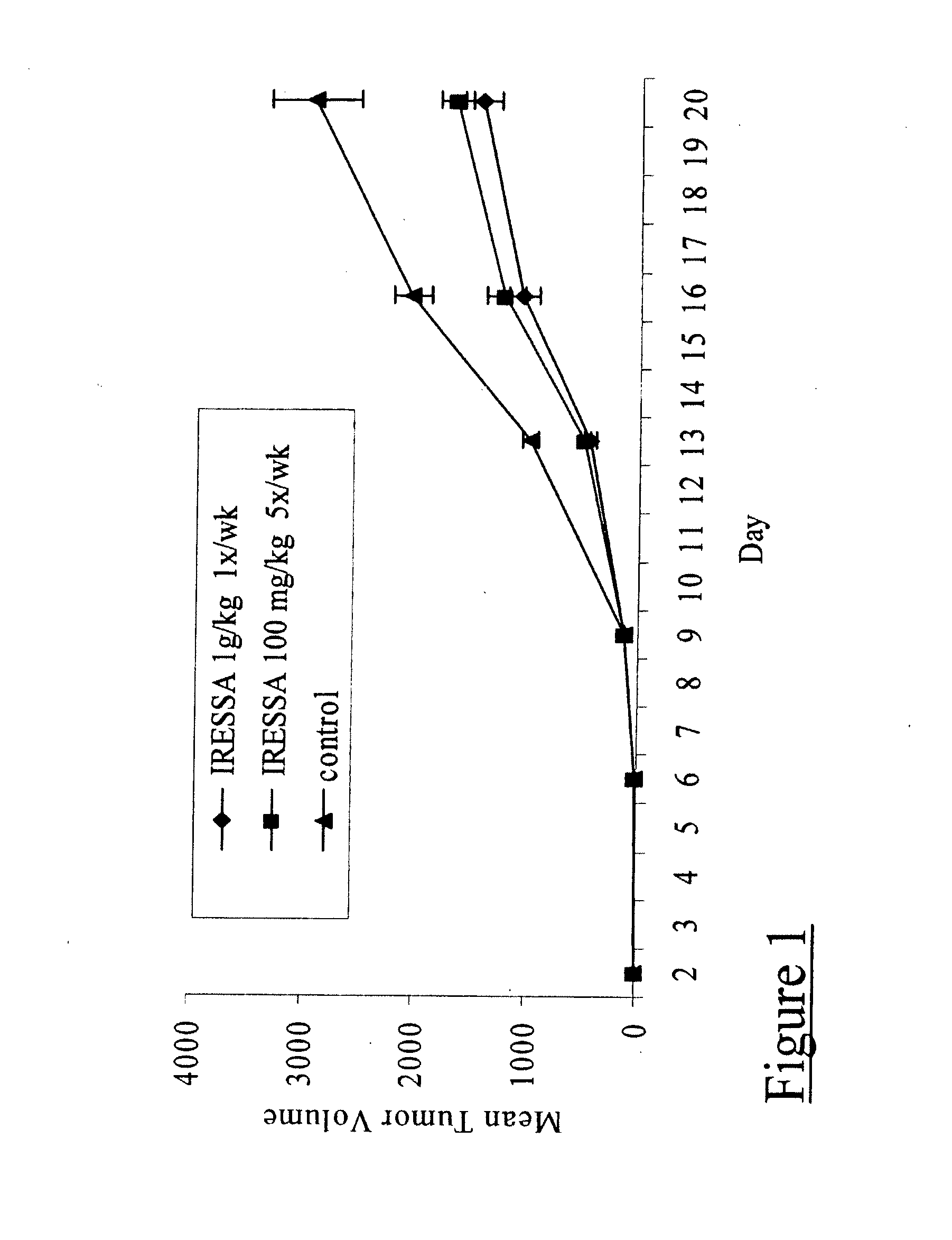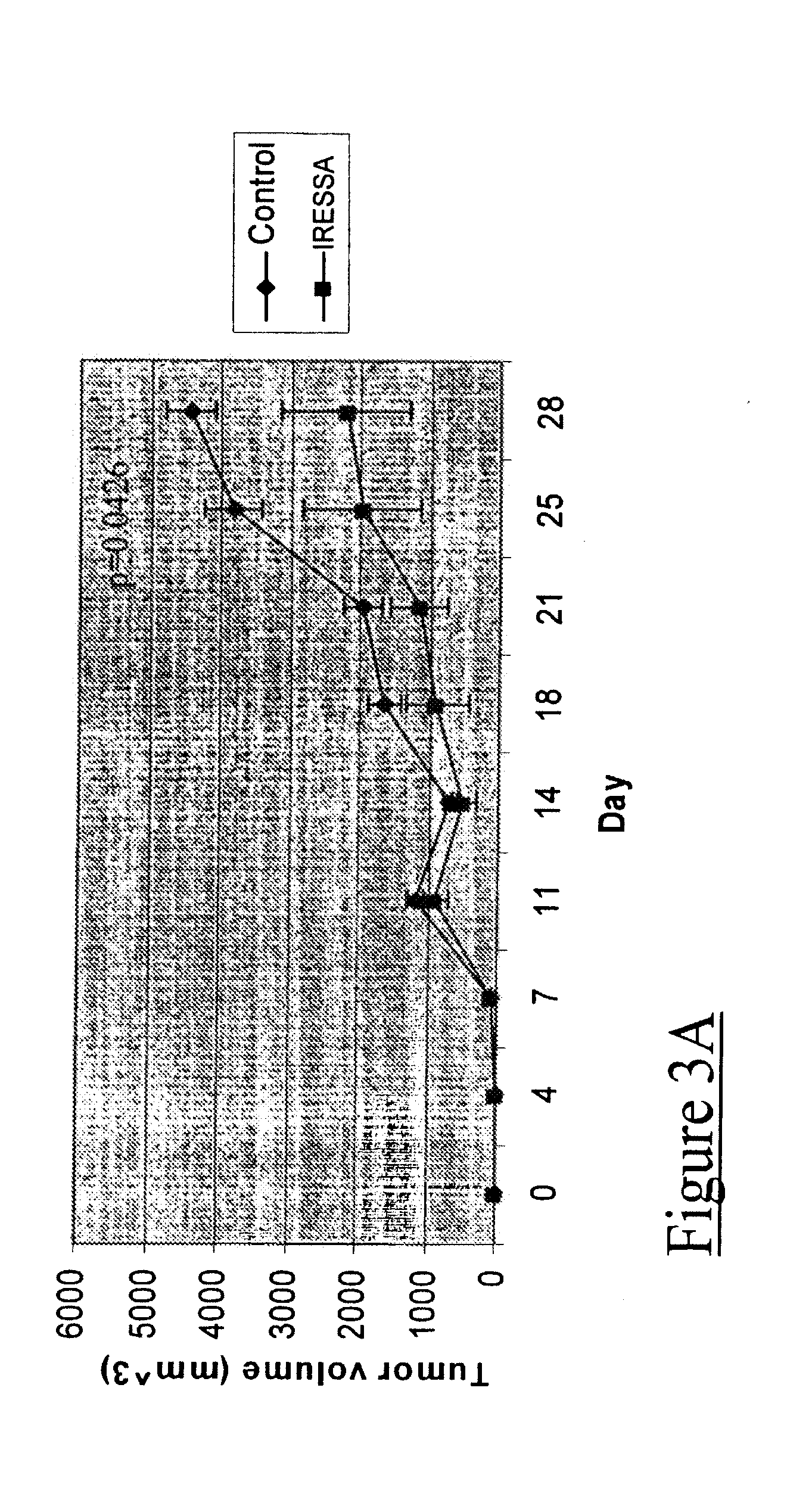Method Of Screening For Sensitivity To Kinase Inhibitor Therapy
a kinase inhibitor and sensitivity technology, applied in the field of disease conditions, can solve the problems of increasing the likelihood that the individual will not respond to therapy, and achieve the effects of less frequency, and preventing the progression of the diseas
- Summary
- Abstract
- Description
- Claims
- Application Information
AI Technical Summary
Benefits of technology
Problems solved by technology
Method used
Image
Examples
example 1
Preparation of Prostate Cancer Xenograft
[0032] IRESSA targets the HER-kinase axis by competing for the ATP binding site on the EGFR molecule, as described above. It has previously been demonstrated to inhibit growth of epithelial cancer xenograft, including prostate tumors. To validate those observations and to also confirm a working model of IRESSA treatment, 8-10 week old athymic nude mice bearing subcutaneous androgen-dependent (CWR22) or androgen-independent (CWR22R) xenograft tumors were administered a daily oral treatment of IRESSA at a dose of 100 mg / kg for three weeks. A significant reduction in tumor volumes was observed (FIGS. 1 and 2) for both the CWR22 (about 50%) and CWR22R (about 66.4%) models; thereby validating the efficacy of IRESSA in androgen-independent prostate cancer.
[0033] Paraffin-embedded sections of the IRESSA-treated tumors were assessed for a decrease in cell proliferation and / or increase in cell apoptosis (data not shown), as these have been previously...
example 2
Development of an In Vivo IRESSA-Resistant Model
[0034] Having identified an androgen-independent prostate cancer model that is sensitive to IRESSA treatment, a corresponding IRESSA-resistant (IR) model was developed to evaluate the mechanisms of resistance with this drug. This was done by serially passaging IRESSA-treated CWR22R tumors in female athymic nude mice for twelve generations (FIG. 4A).
[0035] CWR22R tumors, which first received IRESSA treatment at the initiation of the series, were termed “generation F0.” Generation F0-F3 demonstrated sensitivity to IRESSA after three weeks of treatment (as evaluated by tumor growth curves); similar to that of the native CWR22R tumors. However, by generation F4, tumors demonstrated growth despite the presence of IRESSA. At generation F8, the tumors were characterized as “resistant” after a challenge experiment showed IRESSA to be ineffective in inhibiting tumor growth on two independently derived IR lines as compared to the F0 parental t...
example 3
[0036] IR Tumors CWR22R Tumors are Sensitive to 2C4
[0037] There was a possibility that the serial passaging of tumors coupled with the continuous presence of IRESSA had caused irreversible “damage” to the HER-kinase axis (i.e., a non-functional EGFR pathway, and thus, the observed resistance). To rule out this possibility as a reason for resistance in this model, the IR tumor at generation F12 was treated with either IRESSA (100 mg / kg / day) or 2C4 (20 mg / kg / 2× / wk). 2C4 is a monoclonal antibody against HER-2 that prevents its heterodimerization with HER-1, HER-3 or HERA, and, consequently, inhibits tumor growth by ablating ligand-mediated signaling. Remarkably, after a two-week treatment period, the IR tumors receiving 2C4 showed an 81% growth inhibition as compared to those receiving IRESSA (FIG. 5).
[0038] A combination of 2C4 and IRESSA resulted in a similar growth curve as 2C4 alone, suggesting that IRESSA was unable to potentiate the 2C4 effect. These results conclusively prove ...
PUM
| Property | Measurement | Unit |
|---|---|---|
| resistance | aaaaa | aaaaa |
| volume | aaaaa | aaaaa |
| TKI resistance | aaaaa | aaaaa |
Abstract
Description
Claims
Application Information
 Login to View More
Login to View More - R&D
- Intellectual Property
- Life Sciences
- Materials
- Tech Scout
- Unparalleled Data Quality
- Higher Quality Content
- 60% Fewer Hallucinations
Browse by: Latest US Patents, China's latest patents, Technical Efficacy Thesaurus, Application Domain, Technology Topic, Popular Technical Reports.
© 2025 PatSnap. All rights reserved.Legal|Privacy policy|Modern Slavery Act Transparency Statement|Sitemap|About US| Contact US: help@patsnap.com



